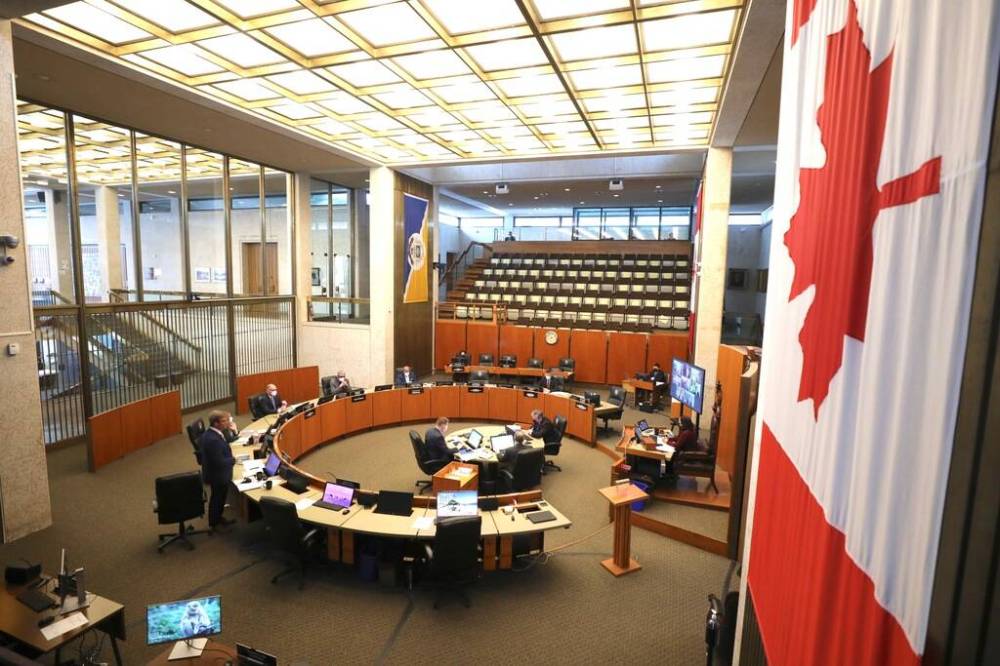Indigenous symbols eyed for council chamber
Advertisement
Read this article for free:
or
Already have an account? Log in here »
To continue reading, please subscribe:
Monthly Digital Subscription
$0 for the first 4 weeks*
- Enjoy unlimited reading on winnipegfreepress.com
- Read the E-Edition, our digital replica newspaper
- Access News Break, our award-winning app
- Play interactive puzzles
*No charge for 4 weeks then price increases to the regular rate of $19.00 plus GST every four weeks. Offer available to new and qualified returning subscribers only. Cancel any time.
Monthly Digital Subscription
$4.75/week*
- Enjoy unlimited reading on winnipegfreepress.com
- Read the E-Edition, our digital replica newspaper
- Access News Break, our award-winning app
- Play interactive puzzles
*Billed as $19 plus GST every four weeks. Cancel any time.
To continue reading, please subscribe:
Add Free Press access to your Brandon Sun subscription for only an additional
$1 for the first 4 weeks*
*Your next subscription payment will increase by $1.00 and you will be charged $16.99 plus GST for four weeks. After four weeks, your payment will increase to $23.99 plus GST every four weeks.
Read unlimited articles for free today:
or
Already have an account? Log in here »
Hey there, time traveller!
This article was published 13/04/2022 (1328 days ago), so information in it may no longer be current.
Alongside the portrait of the Queen and the Canadian flag, the city council chamber walls will soon be adorned with Indigenous symbols, in an attempt at inclusivity.
A report produced in collaboration with the mayor’s Indigenous advisory circle and Tunngasugit, an Inuit non-profit organization, recommends the city add a Dakota land map, sealskin and qulliq oil lamp to the chamber.
“We’re pretty much playing catch up,” said Coun. John Orlikow. “A very important part of history is being recognized and being put on the map, but it’s important Winnipeggers know their Indigenous culture and this is one way to do it.”

The councillor said other Indigenous groups, including the Métis, have been contacted for their input, but have yet to respond to the city.
Damon Johnston, president of the Aboriginal Council of Winnipeg, who is a member of the advisory circle, said chosen objects must meet certain criteria.
“Is it historic? Is it something that was taken without proper permission that belongs to a particular nation?” he asked.
“Depending on where the article came from, if it was donated by a First Nation or other Indigenous group made here, then that’s fine. But if it was just something that was turned over by non-Indigenous organization or museum, then the First Nation should be contacted.”
Tunngasugit chose the qulliq, an oil lamp, and seal skin as their symbols.
“Historically, many places will use an inukshuk to represent the Inuit but that’s really not what we’re all about,” said Nikki Komaksiutiksak, executive director of Tunngasugit. “Especially when it comes to representing us appropriately, the city did a good job by coming to valid organizations and asking them to come aboard.”
Komaksiutiksak first suggested a qulliq oil lamp, used by Inuit to warm the inside of an igloo but with “a very small flame, so it’s not melting,” to cook, and to dry clothing.
“I felt like it was a very important piece to represent the Inuit because that’s what we open up our prayers with, giving thanks and so on and so forth,” said Komaksiutiksak.
She noted that while she knows the seal can be “a contentious item” for animal rights groups, Komaksiutiksak chose seal skin as her second item because they use every part of the animal.
“The seal, for us, is one of the animals that have kept us warm. It’s waterproof,” said Komaksiutiksak. “So we felt that was another very important item to be used to represent our values and family.”
Included with her recommendations, Komaksiutiksak stressed the importance of finding a local Inuk creator to craft the lamp and harvest the seal skin. That way, the city can support local artists and avoid taking an artifact from another province.
“When you go to Vancouver, as soon as you get off the plane, you see exhibits, totem poles, canoes, Indigenous art, you know, it’s right there,” said Johnston. “If you come to our airport, the only thing that speaks to Indigenous people is the Métis Nation advertisement.”
Johnston believes the city should look at placing Indigenous works of art and sculptures downtown. He would like visitors “to understand to some degree Indigenous history in Canada,” as well as “welcome the placement of Indigenous art to brighten up the city” and “acknowledge the first peoples of the land.”
fpcity@freepress.mb.ca

